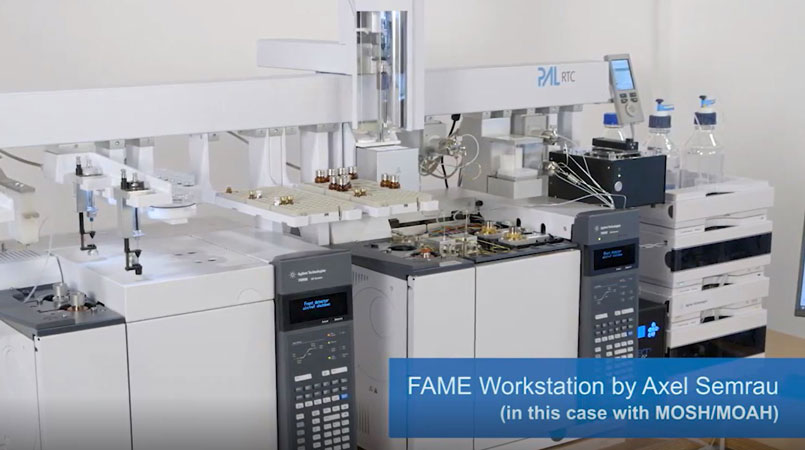FAME analysis (Fatty Acid Methyl Esthers)
CHRONECT Workstation FAME
For the analysis of fatty acid methyl esters (FAME) with respect to their fatty acid composition, there are several methods that Axel Semrau has automated. These are for example the methods DGF C-VI 10 and C-VI 11, SLMB 269.1 and AOCS Ce 2-66. The latter includes methylation with boron trifluoride, a highly toxic chemical – an unpleasant step for any operator. Manual sample preparation must be performed reliably and cleanly to avoid the risk of transfer and to achieve good reproducibility.
Axel Semrau has therefore developed an automated online sample preparation with subsequent gas chromatographic analysis. They have programmed this in CHRONOS Software. The CHRONECT Workbench FAME carries out steps that are difficult to perform manually and performs the sample preparation quickly. In this way, automation not only increases reproducibility but also the sample throughput rate.
Background of FAME
Animal and vegetable fats are essential components of our daily diet and for industrial products such as fats or lubricants. According to the EU food information regulations, manufacturers will be obliged to indicate the fatty acid composition on their packaging from December 2016 onwards. In this way, not only the fatty acid composition is analysed, but also the content of cis and trans fats. In addition, the degree of purity is determined.
Triglycerides of fatty acids cannot be analysed with the gas chromatograph without pre-treatment. Splitting and derivatisation must be carried out in advance. Ester compounds are broken down and the free fatty acids are converted into their corresponding fatty acid methyl esters (FAMEs). Unlike fatty acids, FAMEs are non-polar, moderately volatile and therefore suitable for GC analysis.
The CHRONECT FAME workstation is based on all the steps required for transversal digestion, fatty acid methylation, extraction and injection. An integrated centrifuge accelerates the phase separation. Due to the chromatographic conditions, 27 – 40 samples can be processed within 24 hours.

The autosampler can be adapted quickly and flexibly for alternative sample preparation, e.g. the transesterification of short-chain fatty acids. In addition, different methods can be automated within one workbench.
Benefits of the application:
- Manual treatment limited to sample weighing and solvent exchange
- Safe and user-friendly handling of chemicals
- Clean sample transfer by robots
- Minimal risk of contamination
- Minimisation of the use of small volume solvents
- High reproducibility
- Online linking of autosampler with the analysis
- Increased throughput due to connection with CHRONOS®
- Comparable data for manual sample preparation
Contact Form
This post is also available in: Dutch
